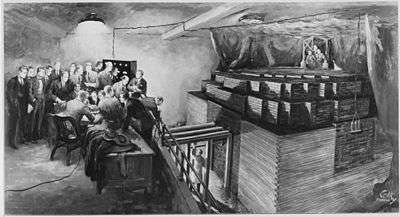1942 in science
| |||
|---|---|---|---|
The year 1942 in science and technology involved some significant events, listed below.
Astronomy
- February 27 – James Stanley Hey, a British Army research officer, first detects radio waves emitted by the sun, helping to pioneer radio astronomy.[1]
- October 3 – The first V-2 rocket is successfully launched from Test Stand VII at Peenemünde, Germany, flying a distance of 147 km and reaching a height of 84.5 km, becoming the first man-made object to reach space.
Biology
- German pathologist Max Westenhöfer first puts forward an aquatic ape hypothesis.[2]
Chemistry

The first man-made nuclear chain reaction becomes self-sustaining in Chicago Pile-1
- Cyanoacrylate adhesive is invented by Harry Coover of Eastman Kodak.[3]
- Eastman Kodak first market Kodacolor color negative film.[4]
Computer science
- John V. Atanasoff with Clifford Berry successfully test the Atanasoff–Berry Computer, the first electronic digital computing device.[5]
Medicine
- Alfred Gilman, Louis S. Goodman and Frederick S. Philips first carry out trials of anti-cancer chemotherapy, using mechlorethamine.[6]
Physics
- August 13 – United States Chief of Engineers, Major General Eugene Reybold formally establishes the 'Manhattan Engineer District' of the Corps of Engineers to undertake production facility construction work for what will become known as the Manhattan Project.[7][8]
- December 2 – Chicago Pile-1, the first nuclear reactor, goes critical under the squash court of the University of Chicago, thanks to the efforts of Enrico Fermi, Leó Szilárd, George Weil and the rest of the Chicago pile team.
Psychology
- Katharine Cook Briggs and her daughter, Isabel Briggs Myers, produce the first Briggs-Myers Type Indicator.
Technology
- March – Isaac Asimov's Three Laws of Robotics are introduced in his short story "Runaround" published in Astounding Science-Fiction.
- July 18 – Messerschmitt Me 262 jet aircraft prototype makes its first flight under jet power.
- August 11 – Composer George Antheil and actress Hedy Lamarr are granted a United States patent[9] for a frequency-hopping spread spectrum communication system intended to make radio-guided torpedoes harder to detect.[10]
- November 26 – First operational military Bailey bridge erected by British Royal Engineers over the Medjerda River near Majaz al Bab in Tunisia.[11]
Births
- January 8 – Stephen Hawking, English physicist and best-selling author of A Brief History of Time
- May 24 – Fraser Stoddart, Scottish-born chemist, recipient of a Nobel Prize in Chemistry
- November 14 – Hanna von Hoerner, German astrophysicist (died 2014)
- November 30 – André Brahic, French astrophysicist (died 2016)
Deaths
- March 10 – William Henry Bragg, English recipient of a Nobel Prize in Physics (born 1862)
- March 14 – Friedrich Karl Georg Fedde, German botanist (born 1873)
- August 12 – Sabina Spielrein, Russian psychoanalyst, in Zmievskaya Balka massacre[12] (born 1885)
- September 22 – Isaak Bacharach, German mathematician (born 1854)
- October 5 – Dorothea Klumpke, American astronomer (born 1861)
- October 27 – Alfred Baker, Canadian mathematician (born 1848)
- November 3 – Ernest Gibbins, English entomologist, speared by Ugandan tribesmen amongst whom he was working (born 1900).
- November 5 – Alexis Carrel, French surgeon, biologist and winner of a Nobel Prize in Physiology or Medicine (born 1873)
- November 13 – Robert Remak, German mathematician, in Auschwitz (born 1888)
- Vernon Orlando Bailey, American naturalist (born 1864)
References
- ↑ Hey, J. S. (1975). The Radio Universe (2nd ed.). Oxford: Pergamon Press. ISBN 0-08-018760-9.
- ↑ Westenhöfer, M. (1942). Der Eigenweg des Menschen. Mannstaedt & Co.
- ↑ "Inventor of the Week Archive". Lemelson-MIT Program. September 2004. Retrieved 2010-02-13.
- ↑ "History of Kodak – 1930-1959". Kodak. Retrieved 2012-01-10.
- ↑ Ralston, Anthony; Meek, Christopher, eds. (1976). Encyclopedia of Computer Science (2nd ed.). pp. 488–489. ISBN 0-88405-321-0.
- ↑ Not published until 1946. Gilman, Alfred (1963). "The Initial Clinical Trial of Nitrogen Mustard". American Journal of Surgery. 105 (5): 574–578. doi:10.1016/0002-9610(63)90232-0. PMID 13947966. Retrieved 2012-05-31.
- ↑ Broad, William J. (30 October 2007). "Why They Called It the Manhattan Project". New York Times. Retrieved 2010-10-27.
- ↑ Jones, Vincent C. (1985). Manhattan, the Army and the atomic bomb. Washington, D.C.: Center of Military History, U.S. Army. pp. 41–43.
- ↑ #2,292,387.
- ↑ Long, Tony (2011-08-11). "This Day in Tech: Aug. 11, 1942: Actress + Piano Player = New Torpedo". Wired. Retrieved 2012-09-26.
- ↑ Harpur, Brian (1991). A bridge to victory: the untold story of the Bailey Bridge. London: HMSO. p. 69. ISBN 0117726508.
- ↑ "Rostov Jewish Community Calls For Survivors, Children to Remember Zmievskaya Balka". Chabad Lubavitch. 2010-05-31. Retrieved 2012-01-04.
This article is issued from Wikipedia - version of the 11/29/2016. The text is available under the Creative Commons Attribution/Share Alike but additional terms may apply for the media files.